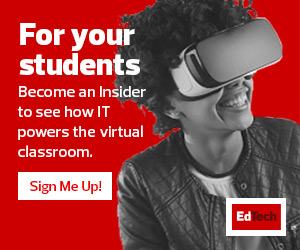As colleges continue to operate with a blend of remote and hybrid learning models, many are seeking new technologies to facilitate classes and learning experiences. From cloud-based applications and collaboration tools to high-performing workstations, new uses of technology are improving education in ways that will outlast the pandemic. Nearly 70 percent of educators say they welcome innovation and are “constantly striving to innovate” with technology, according to a recent report by Promethean.
University departments have traditionally operated in siloes, handling challenges on their own, but many are now collaborating in new ways, says Christian Jones, strategy and planning lead for Z by HP. One outcome is that colleges are better able to leverage technology to address learners’ diverse needs.
For instance, although many educators have adopted tools such as Zoom and Google Classroom, these don’t necessarily have the robustness to fully support academic disciplines such as computer science, design, engineering and architecture. These programs require greater computer power and speed to share complex files and applications than standard collaboration tools may be able to support.
“One of the challenges we’ve worked on is not just about streaming classes and Zoom calls but getting the tools, technology and software into the hands of students that have different levels of devices and internet quality,” says Jones.
HP’s ZCentral Suite Supports Remote Workstation Access
Just before the pandemic, HP launched ZCentral Connect, software designed to simplify the management and sharing of centralized workstations with multiple users. It is part of ZCentral, a suite of high-powered collaboration tools that offer direct workstation access to a hub. ZCentral Remote Boost enables colleges to give students access to powerful computing capabilities through nearly any workstation.
“It enables you to organize all of your computers as a pool of resources that offers remote access and can be streamed into the homes of students,” Jones says.
Capabilities like this allow colleges to offer the full functionality of in-person classes and computer labs to students while still retaining control of intellectual property. Students can access the software, connect to the campus computer from nearly any device and feel as if they are at the university, says Jones. ZCentral Connect enables users to run complex programs and to access performance, applications and files that their machines otherwise wouldn’t be able to access.
MORE ON EDTECH: Here's three technology tips for engaging remote learners.
High-Performing ZBook Studio Enables Multitask Computing
Another step that many administrators have taken to support remote learning is to upgrade antiquated laptops and PCs. HP’s Z Mobile Workstation PCs are built with workflow in mind and offer the power to meet the needs of this new environment, says Anu Herranen, HP’s director of new product introduction.
Unique IP software and solutions maximize the efficiency of the CPU workflow and are especially beneficial for users who need to run — and multitask — complex programs. With strong core performance, the ZBook Studio is designed to deliver professional-caliber performance to product developers, architects and creative professionals. Every ZBook includes access to ZCentral, a high-performance software solution that enables users to share and use computing power from anywhere.
As colleges seek new ways to enhance education from a distance, some are also looking to new technologies such as virtual and augmented reality. HP recently launched the HP Reverb G2 headset, a next-generation device that offers ultrasharp resolution, an ergonomic design and four built-in cameras to track movement.
“What has been surprising in the past 10 months has been how innovative people have been in leveraging VR in commercial environments like education,” says Herranen.
DIVE DEEPER: Virtual reality advances bring new possibilities to higher education.
HP Sure Click Integrates Security for Stronger PC Defenses
Meanwhile, colleges have had to keep security front and center. The U.S. Cybersecurity Infrastructure and Security Agency, along with the FBI, warned in December 2020 about an increase in cyberattacks targeting the K–12 educational sector. Universities have also been prime targets for phishing attacks, malware and ransomware.
HP offers built-in security in its products through HP Sure Click, which strengthens security for the most vulnerable applications with an isolation strategy. Instead of identifying malware, it opens untrusted websites and files in virtual containers that eliminate access to the rest of the machine.
As teaching and learning continue to undergo profound changes in the shift to remote and hybrid education, HP has started creating more content about the reinvention of education worldwide. Jones believes that even as the threat of the virus subsides in the future, colleges have made a giant leap in integrating technologies that will enhance learning.
Universities have “uncovered a lot of things that they don’t want to give up,” says Jones.












